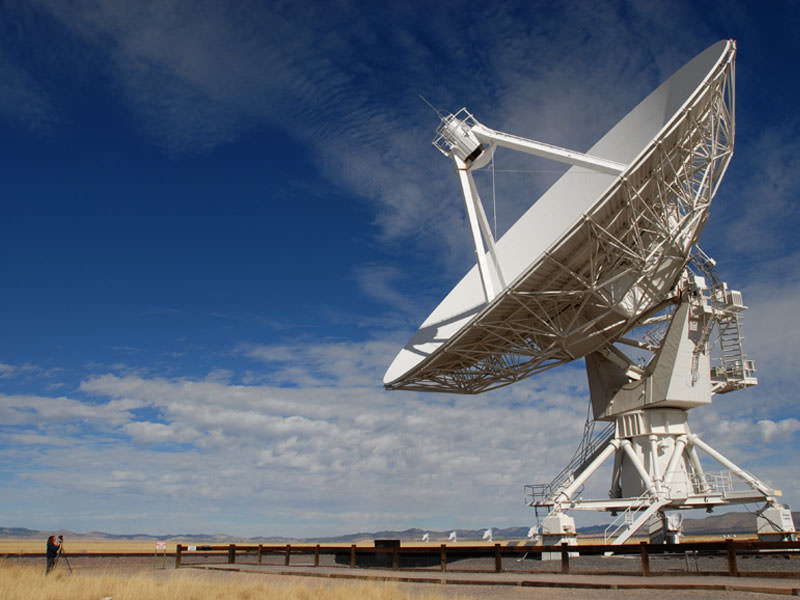Ever wondered what the largest telescope on the Earth is? Well, this coming Wednesday and Thursday of this week, the largest telescope ever assembled here will take observations for a whole day. How big is the telescope? About the size of the whole Earth! 35 radio telescopes on 7 continents will link together for one whole day in an effort to observe distant quasars as part of an initiative to improve the reference frame that scientists use to measure positions in the sky.
Radio telescopes in Asia, Australia, Europe, North America, South America, Antarctica, and in the Pacific will all be linked together to measure the same 243 quasars over a 24-hour period. Quasars are galaxies that have a supermassive black hole at the center, which has strong emissions in the radio spectrum. The quasars being monitored are so far away from the Earth that they appear to be motionless in the sky. This makes them a perfect candidate for setting up a grid in the sky to use as a frame of reference, against which the positions of other objects can be determined.
This monitoring session comes out of a meeting of the International Astronomical Union in August, during which it was decided to start using a set of 295 quasars as a celestial reference frame starting January 1st, 2010. This is not a new reference frame to be used by astronomers – the current one was adopted in 1998 – but an important update to the existing reference frame, the International Celestial Reference Frame.
The session, called the Very Large Astrometry Session is coordinated by the International VLBI Service for Geodesy and Astrometry. Several of the participating observatories will have live webcams running during the event (check for the observatory in your language!), and a public outreach page on the event, hosted by the Bordeaux Observatory, can be found here. The public outreach page will post images as they are taken during the session, with information about observation coordinates.
Radio telescopes like the Very Long Base Array in the United States already link together observatories that are far apart to take observations. This technique is called very long baseline radio interferometry (VLBI), and allows for the use of smaller telescopes that are distant from one another to be linked together and have the same angular resolution as if they were one larger telescope. Doing these observations all in one go will reduce some of the errors that occur when disparate observatories take images at different times.
The previous record for radio observatories linked together to create a larger telescope for one monitoring session is 23. That means that this observing session will beat that record by a whopping 12 additional observatories. Even with this unprecedented amount of observatories monitoring the quasars, there will be a few gaps in the sky, mostly in the Southern hemisphere. Only 243 of the total 295 quasars in the reference frame will be observed this week, though that will break another record for the amount of objects observed in one session using this method. The image below depicts the locations of the participating observatories.
By taking data on the 243 selected quasars, astronomers will be able to more accurately pinpoint objects in the sky in all wavelengths, and gather more precise data. For instance, many objects of scientific interest are monitored by separate telescopes operating in the visible, radio, x-ray and infrared wavelengths. Having a more accurate frame of reference to tell these different telescopes where to point in the sky will improve the ability of the different telescopes to gather information from the same place in space.


Meh – I guess it’s KIND of big.
awaiting new discovery from this event XD
That is a truely awesome flavour of sauce.
Silly question: is there any reason a radio telescope, with an unfoldable dish, cannot be launched into space and placed at the Earth-Sun L4 or L5 point? Combine it with Earth-based telescopes and you’ve got yourself a baseline of 150,000,000 km.
I think read on the NRAO site that 243 quasars will be observed, not 234.
@Adranius V – You’re right – fixed that error of transposition.
@Nexus – There was a space-based VLBI program – Space Very Long Baseline Interferometry – that used satellites in combination with Earth-based telescopes. Here’s a good description of it: http://www.nrc-cnrc.gc.ca/eng/projects/hia/space-observatory.html
Don’t know of any plans to send one to L4 or L5, though, I don’t see why it wouldn’t allow for a baseline of 150,000,000km.
Strange that there are so few stations in the southern hemisphere …
Does anyone know what frequency (or frequencies) the IYA09 Very Large Astrometry Session will operate at? I tried to find it, but couldn’t.
In principle we could have a radio interferometer which is on the scale of the cis-lunar or even the inner solar system. Interferometers of course use the phase difference between different receivers. Over those distances you have to have clocks synchronized, which also has to account for differences in the gravitational potential. A good spacetime geodesy of local region is necessary to correct for errors or drift in clocks. This would have to be good to a billionth of a second per second so the data stream could communicate phase information which can be numerically computed.
LC